They’re out there and they’re looking at you.
Gnomes, monsters, devils and creatures of all shapes, sizes and expressions lurk over doorways all over town. Purely decorative in intent, they differ from gargoyles, whose purpose is to funnel water off rooves.
Carvings like this are hallmarks of the new Gothic trend that was the rage in architecture between 1880 and 1920. Perhaps its greatest expression in NYC is in the many carvings of the 1913 Woolworth Building, which even has carvings of Frank Woolworh and architect Cass Gilbert! These creations are hommages to the great age of European Gothic architecture of the medieval era.
But who’s to say that these aren’t carvings at all, but flesh and blood creatures who come to life at times?

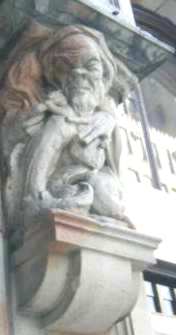
West 29th Street between 7th and 8th Avenues.
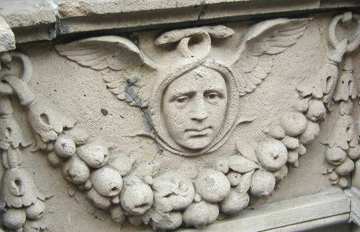
West 10 Street: The wings and snakes mark this carving as Mercury, the messenger god (Greek name Hermes). He was also the patron of inventors and thieves.

8th Avenue and 17th Street. This building has dozens of human faces, all of them different.

Creature heads on Henry Street doorway, Lower East Side
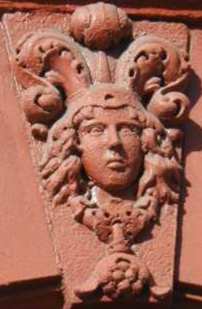

Two more from Henry Street
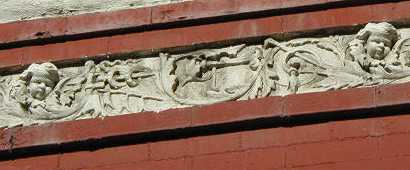
Tiny cherubim on 8th Avenue in Chelsea. Seraphim, depicted as adults, and cherubim, depicted as children, are popular Gothic carved figures. These are very small and are easily overlooked.


LEFT: Galen, (AD 129-210), the historical physician from the Roman era, is depicted with other classical figures, 2nd Avenue north of St. Marks Place; right, gnome at the Clinton School in Chelsea.

West 20 Street: mustachioed figure, possibly the architect or original owner.
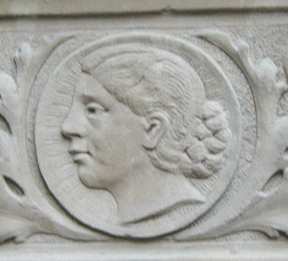
West 21st Street, woman
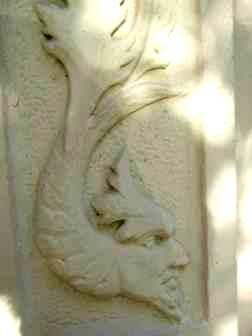
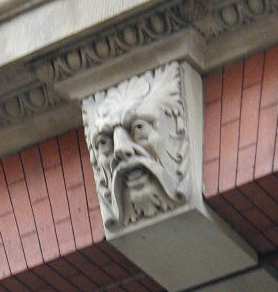

Creatures, West 21st Street

Lion, with modern lighting fixture, East 5th Street
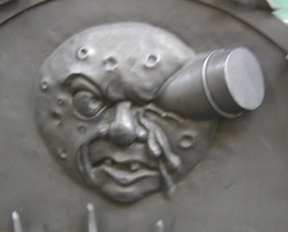

Ironwork, as well, can be adapted for fanciful use. On a West 21st Street gate can be found a recreation of the most famous scene from George Mélies‘ groundbreaking 1902 film A Trip To the Moon.
A Trip to the Moon [Mélies, 1902]
A red-brick building on the southwest corner of 7th Avenue and West 14th Street is notable in many respects for its fanciful ornamentation:

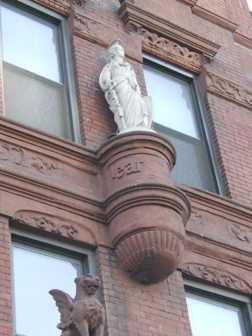
While winged dogs, or perhaps griffins (winged lions) guard the second-floor balcony, there’s a statue of a feminine figure whose identity is thought to be Joan of Arc.

Twin figures with Medusa-like snake hair guard the 14th Street entrance.
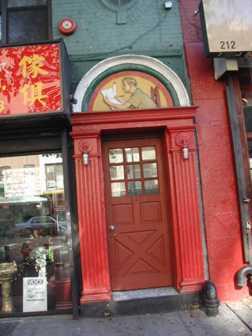
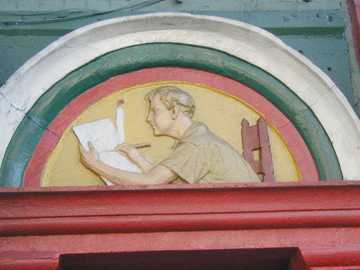
Further west on West 14th Street is an unusual doorway with a hand-painted bas relief of a man sitting at a desk, writing in a notebook by candlelight. Your guess is as good as mine. The picture is beautifully rendered in red, gold and green.

Henry Street, Lower East Side
One of my favorite types of door carvings is the caryatid. Mermaid-like in their leglessness, caryatids are supporting columns in the shape of nude female figures mounted on pedestals on either side of an entranceway.
I was once on a job interview,and I have no idea how it came up, but the interviewer told me that caryatids placed on doorways were meant as a sign that the house was a whorehouse. I have no idea if this is a fact, a common misconception, or whether he just made it up.
St. Mark’s Place near 2nd Avenue in the East Village has two adjacent caryatid-decorated doorways. One poor girl has lost her nose; another, her arm.
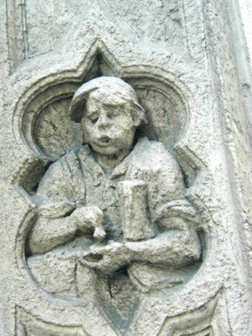

An office building at Madison Avenue near 42nd Street has dozens of sculptures depicting various laborers, some happy, some tired, some disgusted.
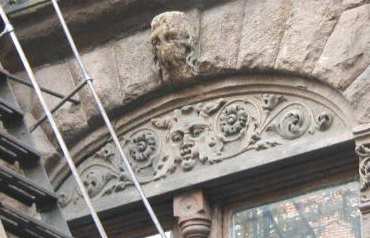
One of the most enduring images in Gothic architecture is that of the Green Man.
He is truly an ancient symbol that has its roots in ancient Eastern mysticism. The Green Man can be found in Turkey, India, Pakistan and points westward to the Atlantic Ocean. The neo-Gothic movement in the USA took him to North America.
He seems to be a part of the foliage itself. His hair and beard are made of leaves. He has been described as a representation of fertility or an embodiment of nature itself. After the middle ages, his image came to be used to bring good fortune on any house where he appears.
Like the Christmas tree, Easter and Halloween, the Green Man is a pagan symbol that has been cleverly incorporated into modern times.
Mike Harding’s Green Man page
And, if it’s New York Gothic carvings that’re your passion…check this out.
Sources:
Over The Door, John Yang, 1995 Princeton Architectural Press. Hundreds more door carvings!
BUY this book at Amazon.COM
1/13/2002




